Chickens are arguably the humblest birds on Earth. As the most common poultry species, they don’t get much thought as long as they keep the eggs and the meat coming. But if you stop to look at them, most are remarkably beautiful creatures…
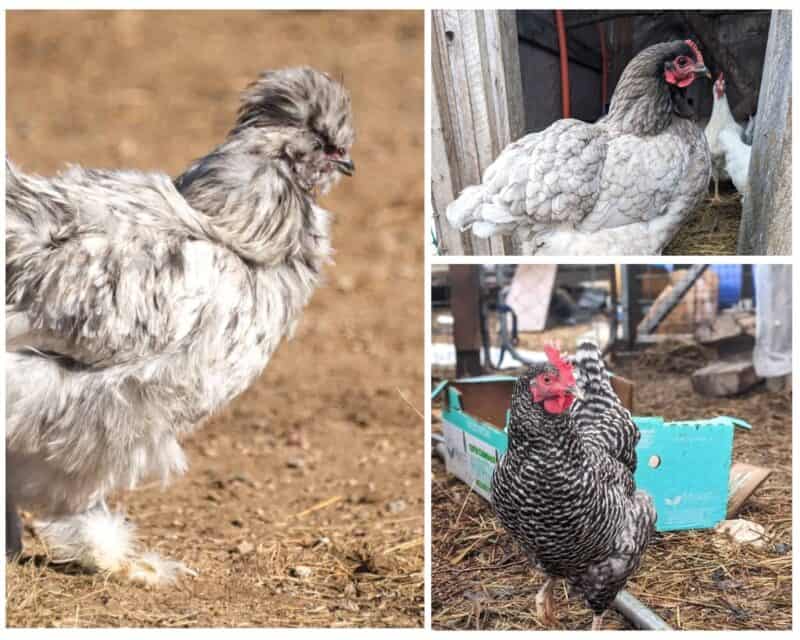
With countless patterns and every color of the rainbow to be found on their feathers, the humble chicken is actually a really impressive specimen! And one of the joys of keeping chickens is having a flock of birds that you like best, one that will bring a lively splash of color to your yard.
But if you like a serious, subtle gray, I’ve got good news for you because there are many chicken breeds that are sure to please you. I’ll tell you about 19 down below.
Gray, or Something Else?
To clear something up really quick before we get to the list, I want to point out that many colors of plumage that will appear gray to your eye aren’t called that when it comes to chickens. Of course not; that would be too easy!
Like the colors of fur or hair on horses and other animals, the color of a chicken’s plumage will often be called something poetic or even esoteric. It isn’t light gray, it’s lavender. It’s not a dark slate gray, it’s blue!
Just keep that in mind as you read through the list below. Rest assured these chickens will appear gray to the eye, but if you go shopping for them, they’ll probably be advertised as something else!
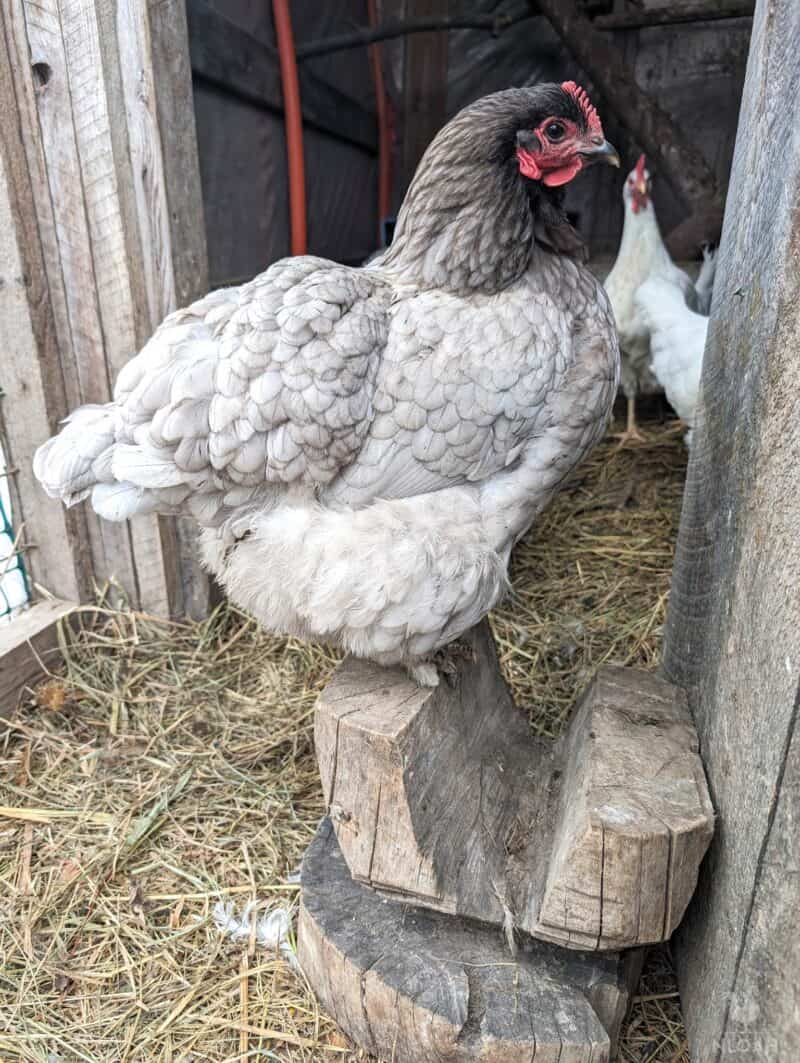
Orpington
The Orpington is one of the most famous and beloved domestic breeds the world over. Big, bulky, fluffy, and famously friendly, they’re also infamously broody, to the point that their modest egg production is typically cut down to a fraction of what it could be because the moms are so intent on hatching their eggs.
But, many keepers use this trait to their advantage and have their Orpington hens adopt and hatch surrogate eggs- even duck eggs!
Owing to their popularity, Orpingtons come in many different colors, and once again blue means a gray hue that we all know and want.
If you want something that is a little bit brighter, the rare lavender Orpington is probably right up your alley, and they have a wonderful sheen in the sunlight that is downright fabulous.
Andalusians
Andalusians are often called “Blue Andalusians” specifically because blue is the most common and famous color.
It takes the form of a wonderfully gorgeous gradient of gray, starting as a charcoal gray at the head and neck before translating to a medium cloudy gray across the back and breast and finally a pale, Dusty gray at the tail feathers and on the underside. Even the scales of their legs are a slate-gray color!
Friendly, curious, and anxious all describe the temperament of the Andalusian, which can make them frustrating or difficult to handle for folks who are not well acquainted with keeping chickens. They also tend to be very noisy when they are stressed out.
Other than that, they make a good dual-use chicken that will produce decent meat and a reasonable number of eggs, though some hands will only lay about 100 a year.
Faverolles
My personal favorite chicken breed is the French Faverolles. Known to be highly energetic, outgoing, curious, and friendly to the point of being a genuine pet, they were originally developed as a chicken for meat and egg production, one that would tolerate long periods of close confinement. Today, you’re more likely to see them as exhibition chickens or kept as backyard birds.
They’re also inseparable from their typical, and unique, salmon coloration which consists of dappled hues of tan, orange, and brown.
That’s not the only plumage varieties they have, though, as they can occasionally be found in a steely blue-gray, or even the remarkably gorgeous blue-salmon; the latter adds in some gray patches to their otherwise pale coloration.
Frizzles
In official circles, “frizzle” is actually a descriptor for a variation of a breed, and indicates birds that have a mutation which sort of bends and turns their feathers outward. But here in the United States, a cottage industry has sprung up breeding all matter of designer Frizzle chickens, and so they are often advertised as a pseudo-breed of their own.
And accordingly, frizzles come in all kinds of different colors, be they the typical colors of a distinct breed, or in the case of a designer Frizzle, blue, gray and other kinds are available.
Hamburgs
Hamburgs are yet another old and venerated European domestic breed, perhaps best known for their particularly striking plumage. Part of this is due to gorgeous colors and patterns, and the other part is due to their remarkably pointed, tight feathers that give them a clean, uniform appearance.
The breed is best known for spangled or penciled variations, but blue is another accepted color according to poultry associations in various countries. It’s quite rare though, so don’t be surprised if you don’t encounter one
Whiting True Blue
If there was ever a time you should judge a book by its cover, it’s probably in the case of the Whiting True Blue. This chicken lays vivid blue eggs and is often found in a pale blue feather color, making them blue through and through!
Originally developed for good looks, great health, and dependably good egg-laying capability, the Whiting True Blue has only recently shown up as a specialty breed among domestic chickens, but is quickly gaining a fan following, especially with those that love gray chickens.
Leghorns
This famous breed is rightly renowned for producing a decent amount of eggs and lots of tender, delicious, and finely-grained meat. Leghorns have a reputation for standoffishness and sometimes outright aggression, but it can still be said that they are a true chicken-lovers chicken.
Stereotypically, it doesn’t get much more generic than a leghorn, with pure white feathers and bright red waddles and combs being the norm.
However, several other colors do exist and are recognized, including lavender, a dusty, slightly iridescent pale gray, and the more traditional blue which is a dark stony gray color. It might be best to admire these big birds from a safe distance, though!
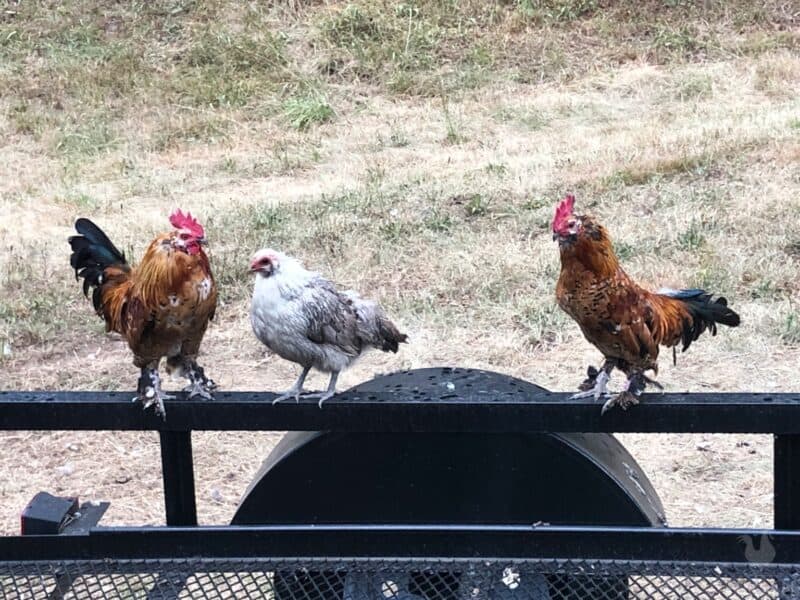
Ameraucanas
Ameraucanas are a US domestic chicken breed developed from the Chilean Araucana, a bird that is famous for its rumpless body, distinct mustache-like tufts, and also, unfortunately, serious genetic problems that lead to high rates of egg failure and death.
The Ameraucana can be found in various colors, but the one on our list that’s most attractive is a dusty gray which is classified as a variation of blue.
This gives them a mature, imposing look thanks to their thick muffs and beards, but they make fine and healthy utility chickens suitable for eggs and meat alike. They also lay blue eggs!
Araucanas
The Araucana, as mentioned above in the entry for Ameraucanas that descended from it, is a unique chicken that lays blue-green eggs and also comes in a gorgeous dark blue coloration which, for normal folks who aren’t crazy about chickens, just means dark gray.
These chickens are unique and something of a vanishing breed today. Most don’t have a rump, meaning they lack a tailbone, and accordingly, they don’t have tail feathers.
This makes them look a little stunted and incomplete, but they are tall, slender, and attractive otherwise, and they look quite charming when they have their long, wispy tuffs sticking out on either side of their head.
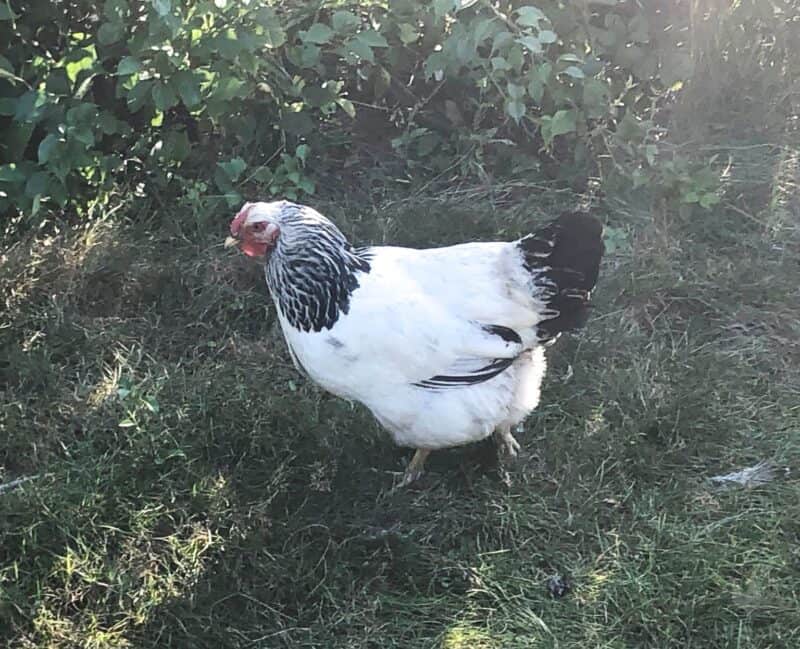
Wyandotte
Another American original, and one that I am thrilled to report is making a comeback from obscurity and near extinction, the Wyandotte is a large, stocky dual-use chicken that is kept for meat and eggs.
This is another breed that is independent, though friendly, and easy to get along with as long as you’re not trying to cuddle it and pet it all the time.
More important for our purposes, the Wyandotte comes in many different colors, and many of them are gray in some way!
Blue is, as always, the expected and typical gray color but you’ll also find lavender for a lighter option. Then we have permutations of these colors in the form of blue-laced, blue-barred, lavender-laced, and silver penciled. If you want a gray flock but you like options, the Wyandotte is as good as it gets.
Naked Neck
When talking about chicken breeds, you’ll rarely hear about the Naked Neck. And no, it doesn’t refer to the gene which can be introduced to any breed; the one that results in featherlessness on the neck and head.
The Naked Neck is actually a distinct breed that has been recognized by the APA since the early 20th century, a dual-use breed that produces a fair amount of eggs, usually around 150 a year or more, and one known for its high carcass yield compared to its weight.
Surprisingly, these completely unique chickens are rarely seen at expos and shows. The US only recognizes four colors as official, and blue isn’t one of them although they do exist and are widely seen in Europe.
As usual, this color is typically a dark gray, although there might be some variation depending on the individual chicken.
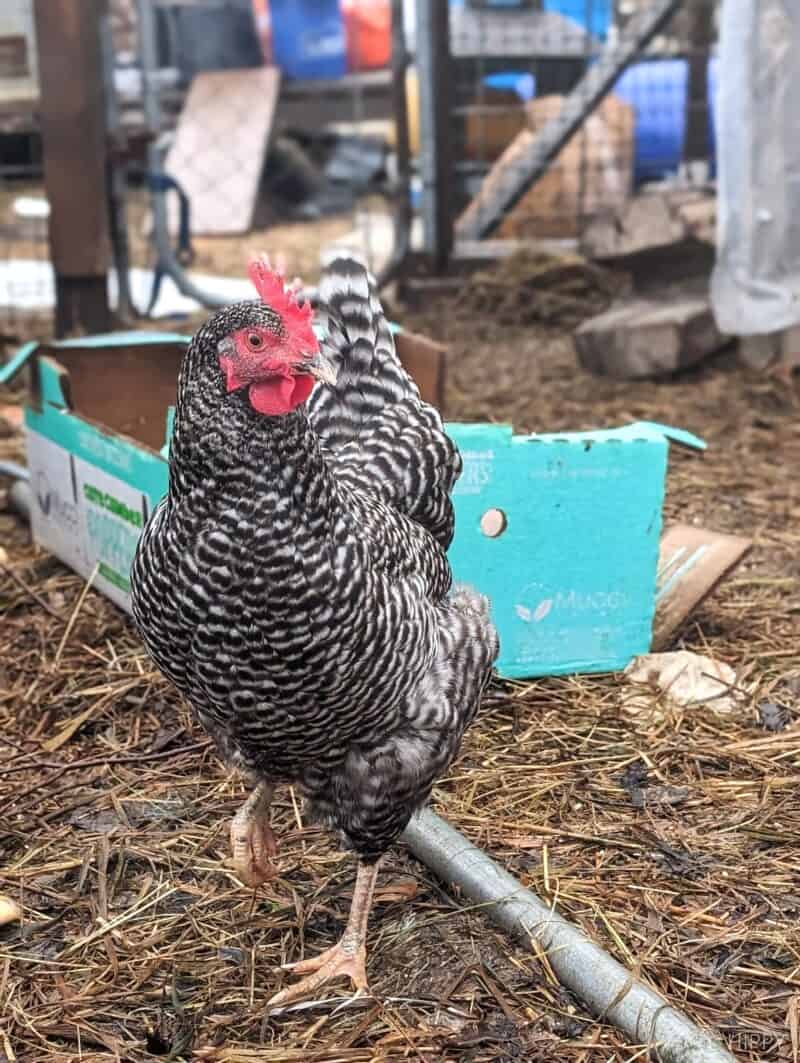
Plymouth Rock
The Plymouth Rock is one of America’s most famous heritage breeds. These stocky utility birds produce a modest amount of eggs and a large yield of meat.
They’re most often thought of in the barred variety, which sometimes lends them the name of Barred Rock for short. It’s sharp, to be sure, but you can also find Plymouth Rocks in the fairly common blue variation.
These chickens are not just good-looking, but also highly resistant to cold weather; a boon in New England where they come from.
Rocks are doting mothers and diligent sitters, so if you want to let your chickens expand the flock in the way that they know best, you can definitely count on the Plymouth Rock.
Sapphire Gems
A hybrid breed, and one not recognized by the APA, the Sapphire Gem is quickly gaining popularity because of its remarkable health and superb egg-laying capability.
The name is a clue to their coloration, a remarkable and unique two-tone blue color, with dark gray up around the neck and head and a pale, speckled gray elsewhere on the body.
As mentioned, these birds are hybrids, but their exact provenance is still somewhat unknown…
Some folks say they’re nothing more than the result of crossbreeding several different types of Plymouth Rock chickens together.
Others claim that they are a combination of heritage breeds developed and then combined somewhere in the Czech Republic before being brought to the US. The few hatcheries out there that sell them aren’t telling, but these birds are beautiful and great egg producers, and fans of them don’t care where they came from.
Minorca
The endangered, rare Minorca is a popular entrant at poultry expos and chicken competitions for obvious reasons: it is amazingly good-looking!
With an upright and athletic body, and huge combs, earlobes and wattles, and dramatic tail feathers these birds are the iconic silhouette of what a chicken should look like.
They are most popularly thought of as either pure, inky black, or bright white, but other color variations exist and are recognized in various countries, though aside from white and black no poultry association really agrees on what is standard for a Minorca otherwise.
In the UK, blue is one of the accepted colors and it certainly suits these majestic birds. The smoky, even gray color lends these chickens a look of true royalty.
If you want a Minorca to call your own, you’ll probably have to search for it and be prepared to pay: they are decidedly uncommon in the United States.
White-Faced Black Spanish
The White-Faced Black Spanish might at first be confused for the Minorca elsewhere on this list. They look very similar, but the obvious distinction is that the white-faced Black Spanish, sometimes just called the Spanish for short, has a bright white face that looks something like a mask.
They are now extremely rare in their native Spain, but can be found elsewhere around the world in their typical jet-black coloring, though a few specialty breeders and countries recognize other colors, a medium gray being one of them.
Pekin
The Pekin is one of the very best chickens for newbies because of its extreme docility. These adorable bantam birds are well known for their extremely fluffy, puffy feathers that makes them appear round and almost pudgy. If you want a chicken that is comfortable being held and petted, the Pekin is a fine choice.
A particularly good choice if you like gray birds is the lavender variation, which has a pale and rippling but slightly iridescent light gray color. They are stunning, and make a truly great pet to boot.
Cochin
The Cochin is a large and thickly feathered breed that is somewhat infamous for broodiness, but well regarded as an exceptionally good mother, one of the only breeds to rival the Orpington in terms of attentiveness to their chicks.
These chickens are extremely popular in the United States, and the American Poultry Association recognizes more than a dozen different individual variations.
The one that we care about, for the purposes of this list, is the lavender variety and it is not APA-recognized, sadly…This variation has been on US shores for a while, and is out there if you have your heart set on a lovely gray chicken to add to your flock.
Australorp
One of the most famous modern domestic chicken breeds, the Australorp is perhaps best known as being the first of the true, supercharged egg-laying breeds of our day: young and productive hens can crank out more than 300 eggs yearly, and even the relatively unremarkable ones will lay about 275.
Just a few of these girls can keep your family well-stocked with eggs in perpetuity!
Aside from their egg-productive capabilities, they’re known to be friendly, adaptable, and pretty healthy. Although, disappointingly, being an Australian breed they aren’t quite as good in blazing hot temperatures as you might expect.
Still, the blue variety is absolutely stunning, and is notable for having a dappled, slightly laced appearance with brownish edges on the feathers. These are good-looking and practical chickens to be sure!
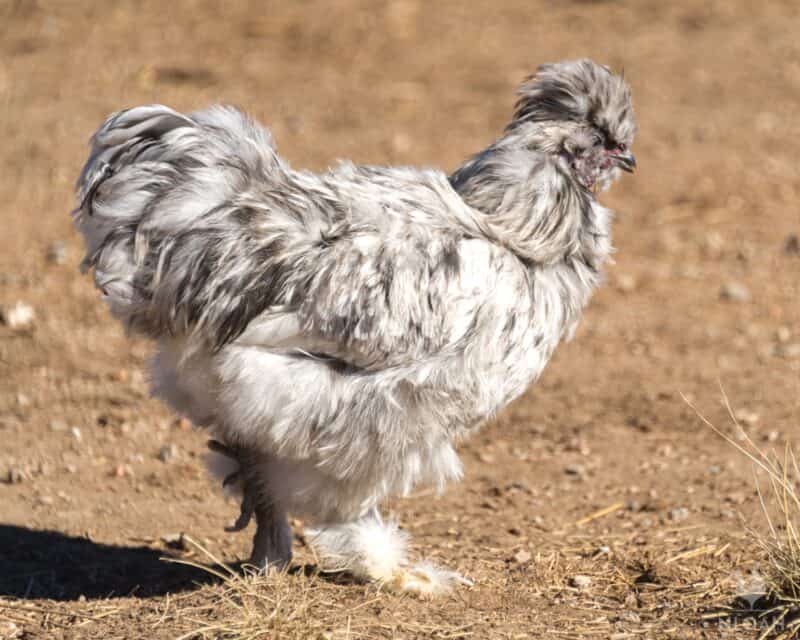
Silkie
And last but not least on our list is the Silkie, known and beloved the world over for its one-of-a-kind, frizzy, and fur-like feathers. That, and also their cute crests that make a wonderful hairpiece!
Silkies are known for their friendliness, but also being “on edge” and slightly neurotic. Hey, if you couldn’t see past your own hair, you’d be nervous too. These are some of the very best chickens you can have if you like interacting with your birds. However, they’re not great for mixed flocks because they have a tendency to wind up at the bottom of the pecking order.
Being such popular ornamentals, there are dozens of color variations out there, and among them are different varieties of blue. They also have gray legs!
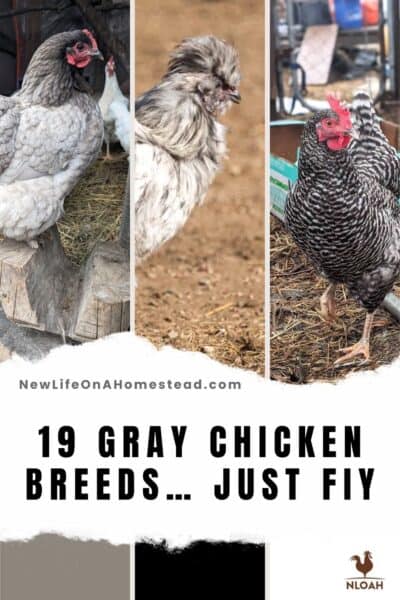
Tom has lived and worked on farms and homesteads from the Carolinas to Kentucky and beyond. He is passionate about helping people prepare for tough times by embracing lifestyles of self-sufficiency.
